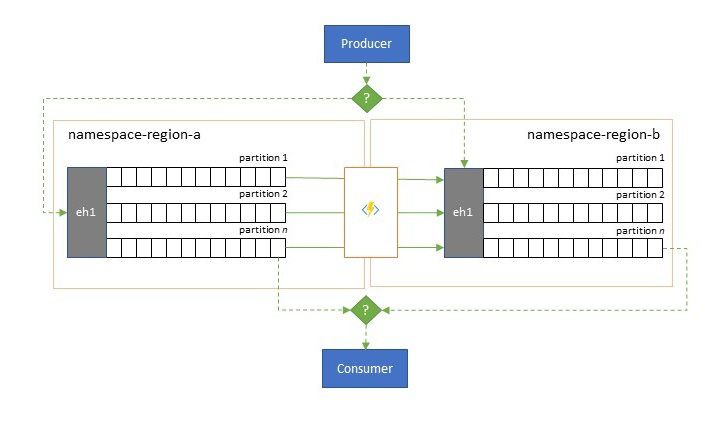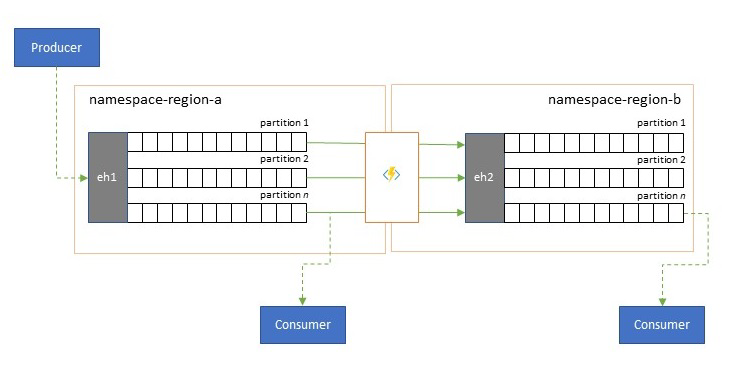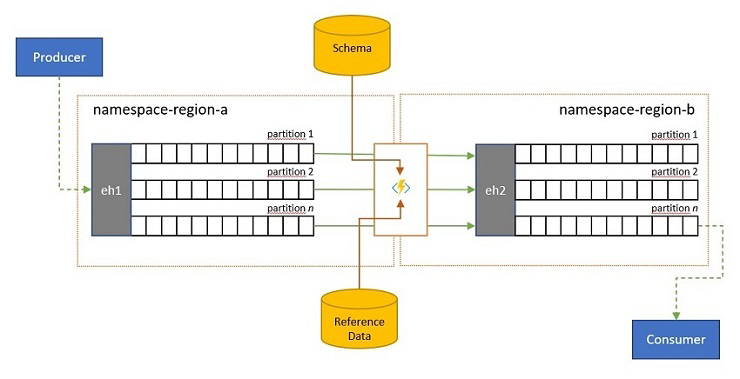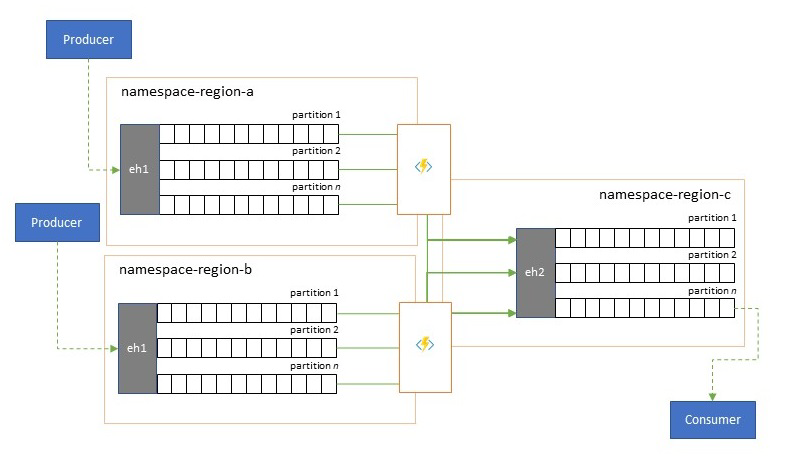Note
Access to this page requires authorization. You can try signing in or changing directories.
Access to this page requires authorization. You can try changing directories.
Many sophisticated solutions require the same event streams to be made available for consumption in multiple locations, or they require event streams to be collected in multiple locations and then consolidated into a specific location for consumption. There's also often the need to enrich or reduce event streams or do event format conversions, also for within a single region and solution.
Practically, that means your solution will maintain multiple Event Hubs, often in different regions and Event Hubs namespaces, and then replicate events between them. You might also exchange events with sources and targets like Azure Service Bus, or Apache Kafka.
Maintaining multiple active Event Hubs in different regions also allows clients to choose and switch between them if their contents are being merged, which makes the overall system more resilient against regional availability issues.
This "Federation" chapter explains federation patterns and how to realize these patterns using the serverless Azure Stream Analytics or the Azure Functions runtimes, with the option of having your own transformation or enrichment code right in the event flow path.
Federation Patterns
There are many potential motivations for why you may want to move events between different Event Hubs or other sources and targets, and we enumerate the most important patterns in this section and also link to more detailed guidance for the respective pattern.
- Resiliency against regional availability events
- Latency optimization
- Validation, reduction, and enrichment
- Integration with analytics services
- Consolidation and normalization of event streams
- Splitting and routing of event streams
- Log projections
Resiliency against regional availability events

While maximum availability and reliability are the top operational priorities for Event Hubs, there are nevertheless many ways in which a producer or consumer might be prevented from talking to its assigned "primary" Event Hubs because of networking or name resolution issues, or where an Event Hubs might indeed be temporarily unresponsive or returning errors.
Such conditions aren't "disastrous" such that you'll want to abandon the regional deployment altogether as you might do in a disaster recovery situation, but the business scenario of some applications might already be impacted by availability events that last not more than a few minutes or even seconds.
There are two foundational patterns to address such scenarios:
- The replication pattern is about replicating the contents of a primary Event Hubs to a secondary Event Hubs, whereby the primary Event Hubs is generally used by the application for both producing and consuming events and the secondary serves as a fallback option in case the primary Event Hubs is becoming unavailable. Since replication is unidirectional, from the primary to the secondary, a switchover of both producers and consumers from an unavailable primary to the secondary will cause the old primary to no longer receive new events and it will therefore be no longer current. Pure replication is therefore only suitable for one-way failover scenarios. Once the failover has been performed, the old primary is abandoned and a new secondary Event Hubs needs to be created in a different target region.
- The merge pattern extends the replication pattern by performing a continuous merge of the contents of two or more Event Hubs. Each event originally produced into one of the Event Hubs included in the scheme is replicated to the other Event Hubs. As events are replicated, they are annotated such that they are subsequently ignored by the replication process of the replication target. The results of using the merge pattern are two or more Event Hubs that will contain the same set of events in an eventually consistent fashion.
In either case, the contents of the Event Hubs will not be identical. Events from any one producer and grouped by the same partition key will appear in the same relative order as originally submitted, but the absolute order of events may differ. This is especially true for scenarios where the partition count of source and target Event Hubs differ, which is desirable for several of the extended patterns described here. A splitter or router may obtain a slice of a much larger Event Hubs with hundreds of partitions and funnel into a smaller Event Hubs with just a handful of partitions, more suitable for handling the subset with limited processing resources. Conversely, a consolidation may funnel data from several smaller Event Hubs into a single, larger Event Hubs with more partitions to cope with the consolidated throughput and processing needs.
The criterion for keeping events together is the partition key and not the original partition ID. Further considerations about relative order and how to perform a failover from one Event Hubs to the next without relying on the same scope of stream offsets is discussed in replication pattern description.
Guidance:
Latency optimization

Event streams are written once by producers, but may be read any number of times by event consumers. For scenarios where an event stream in a region is shared by multiple consumers, and needs to be accessed repeatedly during analytics processing residing in a different region, or with throughout demands that would starve out concurrent consumers, it may be beneficial to place a copy of the event stream near the analytics processor to reduce the roundtrip latency.
Good examples for when replication should be preferred over consuming events remotely from across regions are especially those where the regions are extremely far apart, for instance Europe and Australia being nearly antipodes, geographically and network latencies can easily exceed 250 ms for any round trip. You can't accelerate the speed of light, but you can reduce the number of high-latency round trips to interact with data.
Guidance:
Validation, reduction, and enrichment

Event streams may be submitted into an Event Hubs by clients external to your own solution. Such event streams may require for externally submitted events to be checked for compliance with a given schema, and for non-compliant events to be dropped.
In scenarios where clients are extremely bandwidth constrained as it is the case in many "Internet of Things" scenarios with metered bandwidth, or where events are originally sent over non-IP networks with constrained packet sizes, the events may have to be enriched with reference data to add further context for being usable by downstream event processors.
In other cases, especially when streams are being consolidated, the event data may have to be reduced in complexity or sheer size by omitting some detail.
Any of these operations may occur as part of replication, consolidation, or merge flows.
Guidance:
Integration with analytics services

Several of Azure's cloud-native analytics services like Azure Stream Analytics or Azure Synapse work best with streamed or pre-batched data served up from Azure Event Hubs, and Azure Event Hubs also enables integration with several open-source analytics packages such as Apache Samza, Apache Flink, Apache Spark, and Apache Storm.
If your solution primarily uses Service Bus or Event Grid, you can make these events easily accessible to such analytics systems and also for archival with Event Hubs Capture if you funnel them into Event Hubs. Event Grid can do so natively with its Event Hubs integration, for Service Bus you follow the Service Bus replication guidance.
Azure Stream Analytics integrates with Event Hubs directly.
Guidance:
Consolidation and normalization of event streams

Global solutions are often composed of regional footprints that are largely independent including having their own analytics capabilities, but supra-regional and global analytics perspectives will require an integrated perspective and that's why a central consolidation of the same event streams that are evaluated in the respective regional footprints for the local perspective.
Normalization is a flavor of the consolidation scenario, whereby two or more incoming event streams carry the same kind of events, but with different structures or different encodings, and the events most be transcoded or transformed before they can be consumed.
Normalization may also include cryptographic work such as decrypting end-to-end encrypted payloads and re-encrypting it with different keys and algorithms for the downstream consumer audience.
Guidance:
Splitting and routing of event streams

Azure Event Hubs is occasionally used in "publish-subscribe" style scenarios where an incoming torrent of ingested events far exceeds the capacity of Azure Service Bus or Azure Event Grid, both of which have native publish-subscribe filtering and distribution capabilities and are preferred for this pattern.
While a true "publish-subscribe" capability leaves it to subscribers to pick the events they want, the splitting pattern has the producer map events to partitions by a predetermined distribution model and designated consumers then exclusively pull from "their" partition. With the Event Hubs buffering the overall traffic, the content of a particular partition, representing a fraction of the original throughput volume, may then be replicated into a queue for reliable, transactional, competing consumer consumption.
Many scenarios where Event Hubs is primarily used for moving events within an application within a region have some cases where select events, maybe just from a single partition, also have to be made available elsewhere. This scenario is similar to the splitting scenario, but might use a scalable router that considers all the messages arriving in an Event Hubs and cherry-picks just a few for onward routing and might differentiate routing targets by event metadata or content.
Guidance:
Log projections

In some scenarios, you will want to have access to the latest value sent for any substream of an event, and commonly distinguished by the partition key. In Apache Kafka, this is often achieved by enabling "log compaction" on a topic, which discards all but the latest event labeled with any unique key. The log compaction approach has three compounding disadvantages:
- The compaction requires a continuous reorganization of the log, which is an excessively expensive operation for a broker that is optimized for append-only workloads.
- Compaction is destructive and does not allow for a compacted and non-compacted perspective of the same stream.
- A compacted stream still has a sequential access model, meaning that finding the desired value in the log requires reading the entire log in the worst case, which typically leads to optimizations that implement the exact pattern presented here: projecting the log contents into a database or cache.
Ultimately, a compacted log is a key-value store and as such, it is the worst possible implementation option for such a store. It is far more efficient for lookups and for queries to create and use a permanent projection of the log onto a proper key-value store or some other database.
Since events are immutable and the order is always preserved in a log, any projection of a log into a key-value store will always be identical for the same range of events, meaning that a projection you keep updated always provides an authoritative view and there is never any good reason to rebuild it from the log contents once built.
Guidance:
Replication application technologies
Implementing the patterns above requires a scalable and reliable execution environment for the replication tasks that you want to configure and run. On Azure, the runtime environments that are best suited for such tasks are stateless tasks are Azure Stream Analytics for stateful stream replication tasks and Azure Functions for stateless replication tasks.
Stateful replication applications in Azure Stream Analytics
For stateful replication applications that need to consider relationships between events, create composite events, enrich events or reduce events, create data aggregations, and transform event payloads, Azure Stream Analytics is the best implementation option.
In Azure Stream Analytics, you create jobs that integrate inputs and outputs and integrate the data from the inputs through queries that yield a result that is then made available on the outputs.
Queries are based on the SQL query language and can be used to easily filter, sort, aggregate, and join streaming data over a period of time. You can also extend this SQL language with JavaScript. You can easily adjust the event ordering options and duration of time windows when performing aggregation operations through simple language constructs and/or configurations.
Each job has one or several outputs for the transformed data, and you can control what happens in response to the information you've analyzed. For example, you can:
- Send data to services such as Azure Functions, Service Bus Topics or Queues to trigger communications or custom workflows downstream.
- Send data to a Power BI dashboard for real-time dashboarding.
- Store data in other Azure storage services (for example, Azure Data Lake, Azure Synapse Analytics, etc.) to perform batch analytics or train machine learning models based on very large, indexed pools of historical data.
- Store projections (also called "materialized views") in databases (SQL Database).
Stateless replication applications in Azure Functions
For stateless replication tasks where you want to forward events without considering their payloads or processes them singly without having to consider the relationships of events (except their relative order), you can use Azure Functions, which provides enormous flexibility.
Azure Functions has prebuilt, scalable triggers and output bindings for Azure Event Hubs, Azure IoT Hub, Azure Service Bus, Azure Event Grid, and Azure Queue Storage, as well as custom extensions for RabbitMQ, and Apache Kafka. Most triggers will dynamically adapt to the throughput needs by scaling the number of concurrently executing instances up and down based on documented metrics.
For building log projections, Azure Functions supports output bindings for Azure Cosmos DB and Azure Table Storage.
Azure Functions can run under a Azure managed identity and with that, it can hold the configuration values for credentials in tightly access-controlled storage inside of Azure Key Vault.
Azure Functions furthermore allows the replication tasks to directly integrate with Azure virtual networks and service endpoints for all Azure messaging services, and it is readily integrated with Azure Monitor.
With the Azure Functions consumption plan, the prebuilt triggers can even scale down to zero while no messages are available for replication, which means you incur no costs for keeping the configuration ready to scale back up; the key downside of using the consumption plan is that the latency for replication tasks "waking up" from this state is significantly higher than with the hosting plans where the infrastructure is kept running.
In contrast to all of this, most common replication engines for messaging and eventing, such as Apache Kafka's MirrorMaker require you to provide a hosting environment and scale the replication engine yourself. That includes configuring and integrating the security and networking features and facilitating the flow of monitoring data, and then you still don't have an opportunity to inject custom replication tasks into the flow.
Choosing between Azure Functions and Azure Stream Analytics
Azure Stream Analytics (ASA) is the best option whenever you need to process the payload of your events while replicating them. ASA can copy events one by one or it can create aggregates that condense the information of event streams before forwarding it. It can readily lean on complementing reference data held in Azure Blob Storage or Azure SQL Database without having to import such data into a stream.
With ASA, you can easily create persistent, materialized views of streams in hyper-scale databases. It's a far superior approach to the clunky "log compaction" model of Apache Kafka and the volatile, client-side table projections of Kafka Streams.
For all replication tasks where you want to copy event streams "as-is" and without touching the payloads, or if you need to implement a router, perform cryptographic work, change the encoding of payloads, or if otherwise need full control over the data stream contents, Azure Functions is the best option.
Next Steps
In this article, we explored a range of federation patterns and explained the role of Azure Functions as the event and messaging replication runtime in Azure.
Next, you might want to read up how to set up a replicator application with Azure Stream Analytics or Azure Functions and then how to replicate event flows between Event Hubs and various other eventing and messaging systems: